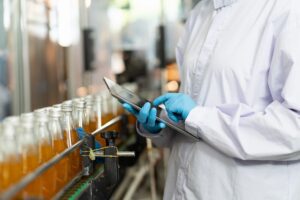Future-proofing Manufacturing: Expert Insights From Dr. Stefan Kozielski, BCG
The tools driving digital transformation in manufacturing are rapidly evolving.
And with these digital innovations comes the challenge of finding the right strategy to bring these different advancements together to unlock new opportunities and improve safety, quality, productivity and profitability.
Recently, Josh Santo, the host of “Conquering Chaos,” our podcast on trends and innovations for manufacturing leaders, spoke with Dr. Stefan Kozielski, associate director of manufacturing and supply chain at Boston Consulting Group (BCG), about building the“factory of the future.”
He’s led companies that include Tyson Group, Henkel and DHL. While he was the director of one of Henkel’s biggest production sites, it was recognized as a “Fourth Industrial Revolution Lighthouse” by the World Economic Forum and won “Factory of the Year” by Kearney.
Today, Dr. Kozielski helps global clients “conquer their chaos” by bringing together the different elements that drive a digital transformation in manufacturing. This includes the big strategic direction decisions on ESG and sustainability, performance, efficiency and people development.
Here we share his lessons and insights on creating a manufacturing factory of the future today.
A Productivity Revolution
Despite the technological disruptions under way, the constant is that a manufacturing factory is still about productivity and achieving an outcome. The future factory is an opportunity to do this more efficiently by optimizing the assets already in place, whether those are machines or the people operating them.
Said Dr. Kozielski:
“When visiting factories, I still see that assets are tremendously underutilized. A 60% OPI or OEE production line is still 40% idle. In my view, the factory of the future is bionic. It has components of human functions and human enablement. It has a clear people focus and creates a workplace for people that enables a productivity revolution.”
The Team User Experience
According to Dr. Kozielski, manufacturing leaders underestimate the importance of the operator and frontline user experience when undertaking digital factory transformation and technology upgrades.
“Everyone has a smartphone, and we all use iPads. And when the app, program or platform is too complicated, we don’t do it,” Dr. Kozielski said.
“If workplace technology doesn’t offer a similarly simple and engaging user experience, then no matter how sophisticated the tech, and how much training is offered, it won’t have the underlying productivity increases assumed when the investment was made.”
The tech experience in manufacturing factories has to offer an experience as straightforward and engaging as what our teams use in their private lives.
Scalability Requires Standardization
The future factory requires digital investments that are efficiently and easily scaled across manufacturing facilities. It’s about taking the successes at one manufacturing location and then adapting them to different sites. ,
Dr. Kozielski cautions against “the lighthouse effect,” which occurs when there are so many different systems and tools across the enterprise that the focus becomes scattered and diffuse. To scale a digital platform system requires standardization.
The Focus On People
The manufacturing industry has a people shortage. In this current war for talent, leaders need to think about how they will make their factories a great place to work. It goes beyond pay or benefits and means looking into how leadership and team culture contributes to increased psychological safety for people.
“Sometimes we are investing too much time to make our offices fancy. But we don’t think with the same strictness and the same vision or passion about how to make our factory a great place to work for our people,” Dr. Kozielski said.
“In every factory, the No. 1 priority is that everyone working there is safe. That’s the physical part of it,” he added. “There’s also the psychological part – how safe people feel and how much additional stress they internalize, leading to burnout and attrition.”
Preventing this is about leadership having the data to set the correct targets, deploy the right tools and enable people to achieve and celebrate those successes. It isn’t about the technology – but what the technology allows for.
Digital tools that reflect the ease of use that people have become accustomed to in their private lives will help with onboarding new talent, upskilling existing teams and facilitating knowledge transfer.
Easier to Work and Learn Together
“It’s the quality of the routines that often makes the difference between a good and a not-so-good factory, and it’s the technologies we introduce that impact the routines,” said Dr. Kozielski.
A people-centered focus on digital transformation recognizes how people work and like to work together, and it’s essential to building a resilient workforce and factory.
“The most powerful driver of resilience is the people, their routines and how they work together in the organization, with the right leadership principles in place and sufficient autonomy to make decisions that are best in line with the purposes of the production,” says Dr. Kozielski.
“Sports are a great way to think about this,” he continued. “The soccer team where the soccer player, with the ball, needs to look to the coach to ask for permission to play it or to ask him what to do with the ball will never win. We have to bring this same concept into our factories.
“We need to make the rules transparent and accessible, give people room for autonomy, and make decisions that drive the plan forward. That, for me, is resilience.”
An Action Plan
Here are the tactical steps manufacturers can do to get started on building a people-focused journey to the factory of the future:
- Do systems and process audits, find the overly complicated processes and assess the breakdown of frontline time. Run shifts together with the operators to better understand their user experience.
- Invest the time to meet with frontline teams to find out what’s working, what’s not and ask what needs to change.
- Do a team and organizational structure audit, looking at the people and roles required to meet your factory ambitions for the future.
- Ask what you can do – not to make an incremental step but to transform how the plant performs. Then try it out as fast as possible in a place where it’s easiest to experiment and then fail super fast if it doesn’t work.
- Set the vision to drive the plant forward and build it by combining both top-down and bottom-up approaches. To be effective requires local and central leadership.
- Position the business case for the digital investment from the perspective of the network (and not just one factory site). It goes beyond the financials to be an investment addressing the labor shortage, sustainability pressures, and the need for an improved employee experience and connection.
The future of manufacturing organizations are factories focused on people, providing the digital tools and transformation designed to benefit their people and increase e productivity, engagement, sustainability and profits.
Want to learn more about operational excellence? Read more about the approach that encompasses all of the solutions you’ll need to maximize efficiency, improve worker safety and create a higher standard of production quality.







